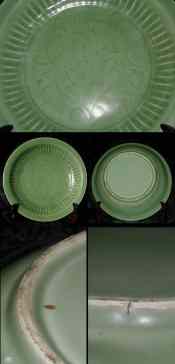
This page is only one of many thousands of Gotheborg.com Help and Information Pages, offering specialized knowledge on Chinese and Japanese Porcelain, including a Glossary, Q&A, Chinese and Japanese Porcelain Marks, Chinese Porcelain Exhibition and Excavation reports etc. For personal help and far more information, join our Discussion Board or use 'Ask a Question' for quick email consultations. For full text and better navigation, use a full-screen device rather than a mobile phone, that offers only limited content.
I have recently purchased a nice Celadon platter that is supposed to be from the Ming Dynasty.
After communicating with my brother who is also a collector, we decided to go ahead with the purchase.
After looking at it carefully in every way, I have concluded that there are two aspects of this piece that worries me.
First of, I'm going to list items that "seem right" for such a Celadon:
What worries me is as follows:
If you can give any opinions of this piece, I will as usual be most grateful. Thanks
Thank you for your question. I would just like to put forward a few suggestions only, and opinions are invited.
Since the pictures you sent were very good I have included them under a thumbnail picture for those interested - or - really concerned. Just click on the picture above to see the close-up.
I can clearly see what worries you, and I have no answer ready. It could be ok but it usually only takes one argument against a piece, to settle that it is a fake, but lets see what we can make out of this.
I believe that what surprises us, is that we do not expect this base on a piece with this decoration. The decoration is to me much rather Northern Song (960-1127) than Ming. This base is impossibly, during Song, to say the least.
The base is absolutely flat and the porcelain body so strengthen with the addition of Kaolin that it does not need the kind of ring support which almost always left a unglazed ring on the base and made it possibly to cover the foot rim with glaze.
Technically this was possibly from the Yuan dynasty when they started to make the big flat blue and white dishes in Jingdezhen.
However, did they ever add Kaolin to the clay in Longquan? As far as I know ring support were used in Longquan well into the 16th century and porcelain with the addition of Kaolin also needs higher temperatures, i.e. different kilns, then you would get in the ordinary dragon kilns of Longquan.
This leaves us really with one conclusion only. Either this dish is not made in Longquan but in Jingdezhen, or it is not Ming.
Regarding a further investigation of this piece, I would like you to investigate the glaze very carefully for scratches. We are talking about a ceramic piece that might be close to 1000 years old. It should - no matter what - show some wear.
Check for scratches that goes all in the same direction and in the same time check for small amounts of modern polishing paste in the pin holes that should be somewhere in the glaze. I have found this on a piece I just recently examined, (which amused me a lot, since I did not own the piece).
Next thing also involves a loupe. I would like you to study the small air bubbles you mention are enclosed in the glaze. They should all be of different sizes, different shapes and unevenly distributed. The uneven temperatures in the old wood fired kiln caused this to happen. Modern glazes have much more evenly distributed bubbles.
As I said - opinions are most welcome. If someone tells me, Yes, Sure, this one is quite ok. They did look like this during ... whaterver - I would accept this at once, but for the time being - I just don't know. It still looks like a Jingedezhen piece to me, and the date to be decided.
Thank you for your interest. Best regards, In Januari 2001 this comment arrived from a friend in Hong Kong which to me makes most other comments unnecessary. It is very serious and don't miss the subtle implications:
Dear Jan-Erik, after reading this page a few points came to me :
Longquan fakes are perhaps the best group of all fakes made, in the sense of high quality and close resemblance to the genuine pieces. Maybe also the group which is availibly in the largest quantities too, probably because they have been so much sought after.
As early as Guangxu (1875-1908) time, there were Japanese dealers permanantly stationed in old Peking to collect Longquan for the Collectors in Japan. I believe Fakes were begining to be made at least from that time and possibly earlier.
Chen Wan Le has made a very extensive studie including several long site visits and excavations in the 1930s, I remember one of his recorded remarks which struck me most was that, in the Zhejiang Longquan areas, Chen was seeing more Longquan wares made in Jingdezhen than Zhejiang Longquan pieces. Every villager was trying to sell him a Longquan fake.
If I tell my HK dealer friends that I have acquired a wonderful master piece of Longquan, the dealer would say ' I'll have to see and check it'.
As for the piece in your page: the form, the colour of the glaze and the incised pattern of the platter, I have not seen in my Longquan books, catalogues or museums I have visited. But I recall and recognise it from the HKshops with low reputations.
Simon Ng

Click picture for enlarged view!
A few suggestions - opinions invited
Jan-Erik NilssonComment